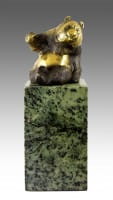A Wide Range of Styles and Subjects
From realistic wildlife sculptures to stylized, modern interpretations, our animal sculptures cover a broad spectrum of artistic expression. You'll find:
- Lifelike representations of animals such as horses, lions, birds, elephants, owls, dogs, and cats — sculpted with precision and emotion.
- Symbolic and spiritual pieces, including animals associated with mythology or cultural significance, like dragons, koi fish, or wolves.
- Abstract and contemporary designs for modern interiors and minimalist outdoor spaces.
Every piece is carefully selected for its artistic value, character, and ability to complement various design styles — from rustic countryside charm to urban elegance.
Bronze Animal Sculptures – Timeless Craftsmanship
Few materials convey power, tradition, and elegance like bronze. Our bronze animal sculptures are cast using traditional methods like lost-wax casting, allowing for rich textures and remarkable detail. These sculptures make a lasting impact, ideal as indoor statement pieces or as enduring features in gardens and courtyards.
Thanks to the natural aging process of bronze, each sculpture develops a unique patina over time, enhancing its character and visual appeal. Whether you're displaying a powerful stallion, a poised eagle, or a meditative turtle, bronze captures the essence of the animal with unmatched realism and gravitas.
Garden Animal Sculptures – Bring Your Outdoor Space to Life
Our garden animal sculptures are designed not just to decorate, but to become a part of the landscape. Whether nestled among flowers or standing proudly on a lawn, these sculptures create focal points and invite interaction. Place a majestic deer beneath a tree, add charm with a family of ducks by a pond, or install a pair of lions at your garden entrance for a bold, regal effect.
Crafted from weather-resistant materials such as stone, metal, and high-grade resin, these sculptures are built to withstand rain, sun, frost, and time. They bring personality and storytelling into the garden — making nature not just a backdrop, but a gallery.
Indoor Animal Sculptures – Natural Elegance for Your House Decor
Animal-themed art brings warmth, symbolism, and a sense of organic life into the home. Our indoor animal sculptures are ideal for elevating your house decor, whether placed on shelves, mantels, side tables, or windowsills. Choose from small decorative figurines or medium-sized sculptures that serve as artistic accents in any room.
A bronze elephant can symbolize wisdom and stability in the living room, a bird in flight can bring freedom and inspiration to your workspace, and a sleeping fox can add charm and comfort to a cozy reading nook.
These pieces don't just decorate — they resonate emotionally and visually, often sparking conversation and evoking a sense of connection to nature.
Perfect for Collectors, Designers, and Animal Lovers
Our animal sculptures appeal to a wide range of people:
- Interior designers seeking meaningful décor pieces for clients
- Art collectors who value fine craftsmanship and symbolism
- Garden enthusiasts looking to personalize their landscapes
- Animal lovers who want to celebrate their favorite creatures in art
With options in various sizes, finishes, and price points, there's a sculpture for every setting and style — whether you're decorating a private home, a public garden, a hotel, or a meditation space.
Explore Our Animal Sculptures Collection Today
Nature speaks through form, movement, and emotion — and our sculptures capture it all. Discover the perfect piece from our wide range of bronze animal sculptures, garden animal sculptures, and interior decorative works that blend artistry with storytelling.
Browse our animal sculptures for garden and home, and turn your spaces into living, breathing works of art.






























